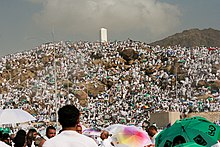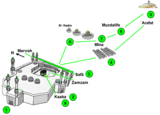Dhu al-Hijja
This article needs additional citations for verification. (July 2020) |
| Dhu al-Hijja | |
|---|---|
 The Kaaba during Hajj | |
| Native name | ذُو ٱلْحِجَّة (Arabic) |
| Calendar | Islamic calendar |
| Month number | 12 |
| Number of days | 29-30 (depends on actual observation of the moon's crescent) |
| Significant days | |
| Islamic calendar |
|---|
| Months |
Dhu al-Hijjah (Arabic: ذُو ٱلْحِجَّة, romanized: Ḏū al-Ḥijja IPA: [ðu‿l.ħid͡ʒ.d͡ʒah]) is the twelfth and final month in the Islamic calendar.[1] Being one of the four sacred months during which war is forbidden, it is the month in which the Ḥajj (Pilgrimage) takes place as well as Eid al-Adha, the “Festival of the Sacrifice.”
The Arabic name of the month, Dhu al-Hijja, means "Possessor of the Pilgrimage" or "The Month of the Pilgrimage".[1] During this month, Muslim pilgrims from all around the world congregate at Mecca to visit the Kaaba. The Hajj rites begin on the eighth day and continue for four or five days. The Day of Arafah takes place on the ninth of the month. Eid al-Adha, the "Festival of the Sacrifice", begins on the tenth day and ends on the thirteenth day.[1]
The name of this month is also spelled Dhul-Hijja or Zu al-Hijja. In modern Turkish, the name is Zilhicce also spelled as Zilhacce.[1]
Timing[edit]
The Islamic calendar is a lunar calendar, and months begin when new moon is sighted. Since the Islamic lunar calendar year is 11 to 12 days shorter than the solar year, Dhu al-Hijja migrates throughout the seasons. The estimated start and end dates for Dhu al-Hijja, based on the Umm al-Qura calendar of Saudi Arabia, are:[2]
| AH | First day (CE/AD) | Last day (CE/AD) |
|---|---|---|
| 1443 | 30 June 2022 | 29 July 2022 |
| 1444 | 19 June 2023 | 18 July 2023 |
| 1445 | 7 June 2024 | 6 July 2024 |
| 1446 | 28 May 2025 | 25 June 2025 |
| 1447 | 18 May 2026 | 15 June 2026 |
Special days[edit]

- The first 9 days of Dhu al-Hijja for fasting
- The first 10 nights of Dhu al-Hijja for standing (Qiyaam) in Tahajjud
- The 8th, 9th and 10th of Dhu al-Hijja as the days of Hajj
- The 9th of Dhu al-Hijja as the Day of Arafah
- Takbirut Tashreeq is observed from the 9 Dhu al-Hijja till 13 Dhu al-Hijja
- The 10th of Dhu al-Hijja as the Day of Eid
- Eid al-Adha (Festival of the Sacrifice) is observed by Muslims on the hajj and around the world in commemoration of the willingness of Ibrahim (Abraham) to sacrifice his son Isma'il (Ishmael) for Allah, begins on the 10th day of Dhu al-Hijja and ends on sunset of the 13th Dhu al-Hijja
- 18th Dhu al-Hijja - Eid-al-Ghadeer
Prescribed acts of worship[edit]
The following acts have been prescribed for the first nine days of Dhu al-Hijja:
- A person should give extra charity Sadaqah in these 9 days
- Better your Salaah in these days
- Spend time in the Masjid
- Perform voluntary Nafl prayer at home
- Recitation, Memorization and Reading of the Qur’an
- Dhikr
- Dua
- Fasting the first nine days sawm
- Iʿtikāf
On the days of Qurbani, i.e. 10th, 11th, 12th and 13th of Dhu al-Hijja, the greatest action is the spilling of blood of a sacrificial animal.
Hadiths[edit]
One of the wives[vague] of Muhammad said: "Allah's Messenger used to fast the [first] nine days of Dhul-Hijjah, the day of 'Ashurah, and three days of each month." (Reported by Abu Dawud)[3]
Reward for fasting and Tahajjud[edit]
According to the hadith, great rewards have been mentioned for fasting the first nine days of Dhu al-Hijja and standing in worship (Tahajjud) in the first 10 nights of Dhu al-Hijja:
The Prophet of Allah said: There are no days more beloved to Allah that he be worshipped in them than the ten days of Dhu al-Hijjah, fasting every day of them is equivalent to fasting a year; and standing every night of them (in Salaah) is equivalent to standing on the Night of Qadr.
— Tirmidhi, 758
This hadith has been classed as a daeef(weak) hadith by many scholars,
Narrated by at-Tirmidhi (no. 758); al-Bazzaar (no. 7816) and Ibn Maajah (1728) via Abu Bakr ibn Naafi‘ al-Basri, who said: Mas‘ood ibn Waasil told us, from Nahhaas ibn Qaham, from Qataadah, from Sa‘eed ibn al-Musayyab, from Abu Hurayrah.
This is a da‘eef isnaad because of an-Nahhaas ibn Qaham and Mas‘ood ibn Waasil. Hence the scholars of hadith unanimously agreed that it is to be classed as da‘eef.
At-Tirmidhi (may Allah have mercy on him) said:
This is a ghareeb hadith, which we know only from the hadith of Mas‘ood ibn Waasil, from an-Nahhaas.
I asked Muhammad – i.e., al-Bukhaari – about this hadith and he did not know it except via this isnaad.
Some of this was also narrated from Qataadah, from Sa‘eed ibn al-Musayyab, from the Prophet (blessings and peace of Allah be upon him) in a mursal report. Yahya ibn Sa‘eed criticised Nahhaas ibn Qaham with regard to his memory. End quote.
Al-Baghawi (may Allah have mercy on him) said:
Its isnaad is da‘eef (end quote)
Sharh as-Sunnah (2/624)
Shaykh al-Islam Ibn Taymiyah (may Allah have mercy on him) said:
There is some weakness in it. End quote
Sharh al-‘Umdah (2/555)
Al-Haafiz Ibn Hajar (may Allah have mercy on him) said:
Its isnaad is da‘eef. End quote.
Fath al-Baari (2/534)
It was classed as da‘eef by Shaykh al-Albaani (may Allah have mercy on him) in as-Silsilah ad-Da‘eefah (no. 5142).
The reason for the 10 days being distinguished is due to the combination of worship in this period of prayer, fasting, charity, Takbir and Hajj.
From the first nine days of Dhu al-Hijja, it is particularly recommended to fast the Day of Arafah (9 Dhu al-Hijja) as expiation of the sin of two years:
Abu Qatada narrates that Muhammad was asked about fasting on the Day of Arafah. He said: as for the fasting on the Day of Arafah, I anticipate that Allah will forgive the year (i.e. the sins of the year) after it and the year before it.
— Tirmizi, 758
General events[edit]
Sunni[edit]
- 18 Dhu al-Hijja, assassination of Uthman, the prominent companion and son-in-law of Muhammad and Khadija. Husband of Ruqayyah and Umm Kulthum.
Shi'ite[edit]
- 01 Dhu al-Hijja, Nikah (marriage) of Ali and Fatimah – AH 2 (24 February AD 624).
- 07 Dhu al-Hijja, martyrdom of Twelver and Ismāʿīlī Shīʿite Imām, Muhammad al-Bāqir ‐ AH 114.
- 08 Dhu al-Hijja, Husayn ibn ʿAlī began his journey to Karbalāʾ from Mecca.
- 09 Dhu al-Hijja, martyrdom of Muslim ibn ʿAqīl and Hani ibn Urwah in Kufah. It is also a day of supererogatory fasting – AH 60.
- 15 Dhu al-Hijja, birth of Twelver Imām, ʿAlī al-Naqī - AH 214 [Disputed date].
- 18 Dhu al-Hijja, Shīʿite Muslims celebrate the event of Ghadir Khumm - AH 10.
- 19 Dhu al-Hijja, Fatimah went to Ali's house after their marriage.
- 23 Dhu al-Hijja, martyrdom of Meesam Tammar, friend of Ali – AH 60.
- 23 Dhu al-Hijja, martyrdom of two sons of Muslim ibn ʿAqīl in Kufa - AH 60.
- 24 Dhu al-Hijja, event of al-Mubahalah took place ('Eid al-Mubahilah).
- 24 Dhu al-Hijja, some historians mention that the Hadith, Ahl al-Kisa', event was also on the same day prior to Muhammad setting out for Mubahila.
- 24 Dhu al-Hijja, supplication day and giving of alms with the ring by Ali. In reply verse, "Verily your Walee is Allah; and His Messenger and those who establish Salaat, and pay Zakaat while they be in Rukooʿ. (Maa-Idah: 55)" was revealed.
- 25 Dhu al-Hijja, Sura Al-Insan or Hal Ata, or Dahar, which records the giving of alms to orphans, the destitute and travellers by Fatimah Hasan and Husain was revealed.
- 25 Dhu al-Hijja, Ali becomes the Caliph of Islam – AH 35.[citation needed]
Notes[edit]
References[edit]
- ^ a b c d Yaşaroğlu, M.Kâmil (2013). "ZİLHİCCE". TDV Encyclopedia of Islam, Vol. 44 (Yusuf – Zwemer) (in Turkish). Istanbul: Turkiye Diyanet Foundation, Centre for Islamic Studies. pp. 415–416. ISBN 978-975-389-785-3.
- ^ Umm al-Qura calendar of Saudi Arabia
- ^ "Ten Blessed Days of Dhul Hijjah | Soul". Central-mosque.com. Archived from the original on 2013-09-28. Retrieved 2013-09-26.
External links[edit]
- Islamic-Western Calendar Converter (based on the Arithmetical or Tabular Calendar).
- Hadith on Dhul-Hijjah

